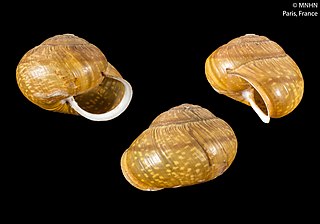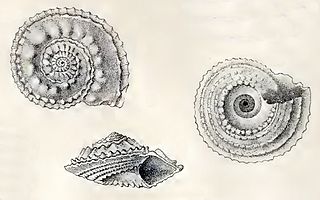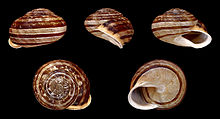
The grove snail, brown-lipped snail or lemon snail is a species of air-breathing land snail, a terrestrial pulmonate gastropod mollusc.

The white-lipped snail or garden banded snail, scientific name Cepaea hortensis, is a large species of air-breathing land snail, a terrestrial pulmonate gastropod mollusc in the family Helicidae. The only other species in the genus is Cepaea nemoralis.

Cornu aspersum, known by the common name garden snail, is a species of land snail in the family Helicidae, which includes some of the most familiar land snails. Of all terrestrial molluscs, this species may well be the most widely known. It was classified under the name Helix aspersa for over two centuries, but the prevailing classification now places it in the genus Cornu.

Helix pomatia, common names the Roman snail, Burgundy snail, or escargot, is a species of large, air-breathing stylommatophoran land snail native to Europe. It is characterized by a globular brown shell. It is an edible species. Helix pomatia commonly occurs synanthropically throughout its range.

Zonitoides nitidus is a species of small, air-breathing land snail, a terrestrial pulmonate gastropod mollusc in the family Gastrodontidae.

Arianta arbustorum, sometimes known as the copse snail, is a medium-sized species of pulmonate land snail in the family Helicidae.

Helix lucorum is a species of large, edible, air-breathing land snail, a terrestrial pulmonate gastropod mollusk in the family Helicidae, the typical snails.

Caucasotachea vindobonensis is a large species of air-breathing land snail, a terrestrial pulmonate gastropod in the family Helicidae.

A land snail is any of the numerous species of snail that live on land, as opposed to the sea snails and freshwater snails. Land snail is the common name for terrestrial gastropod mollusks that have shells. However, it is not always easy to say which species are terrestrial, because some are more or less amphibious between land and fresh water, and others are relatively amphibious between land and salt water.

Cernuella virgata, also known as Helicella virgata, common name, the "vineyard snail", is a species of small, air-breathing land snail, a pulmonate gastropod mollusc in the family Geomitridae.

Theba pisana, common names the white garden snail, sand hill snail, white Italian snail, Mediterranean coastal snail, and simply just the Mediterranean snail, is an edible species of medium-sized, air-breathing land snail, a terrestrial pulmonate gastropod mollusk in the family Helicidae, the typical snails.

Cochlicella acuta, common name the pointed snail, is a species of small but very high-spired, air-breathing land snail, a pulmonate gastropod mollusk in the family Geomitridae.

Helicodonta obvoluta is a species of air-breathing land snail, a terrestrial pulmonate gastropod mollusk in the family Helicodontidae.

Ashfordia granulata, common name the "silky snail", is a species of medium-sized air-breathing land snail, a terrestrial pulmonate gastropod mollusk in the family Hygromiidae, the hairy snails and their allies.

The marine snail Norrisia norrisii is a medium-sized gastropod mollusk within the family Tegulidae. It has several common names, including Norris's top snail, Norris's topsnail, norrissnail, smooth brown turban snail, or kelp snail. It was first described by G.B. Sowerby I under the name Trochiscus norrisii.

Calliotropis spinulosa is a species of small sea snail, a marine gastropod mollusk in the family Eucyclidae.

Ethaliella floccata is a species of sea snail, a marine gastropod mollusk in the family Trochidae, the top snails.

Minolia ceraunia is a species of minute sea snail, a marine gastropod mollusk in the family Solariellidae.

Helix albescens is a species of air-breathing land snail belonging to the family Helicidae. It is often found in Southeastern Europe and the surrounding areas. It is commonly known as the white-lipped snail or the whitish snail due to its distinctive white lip.

Helix cincta is a species of gastropods belonging to the family Helicidae.



























